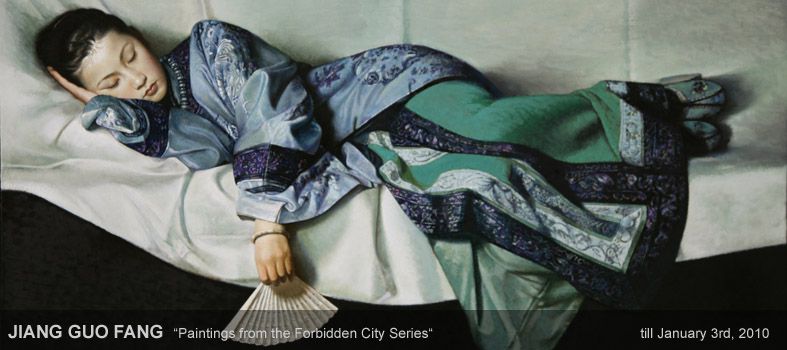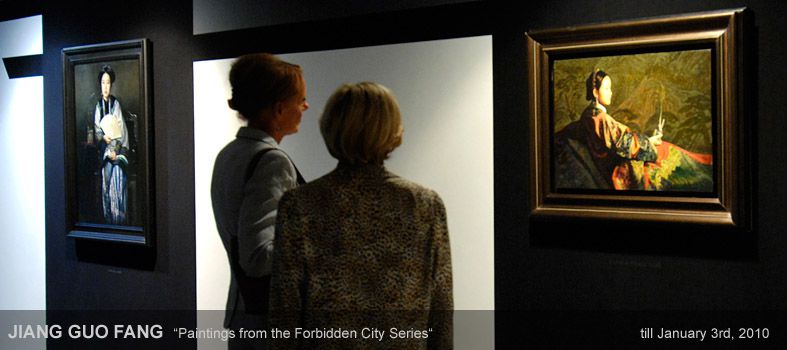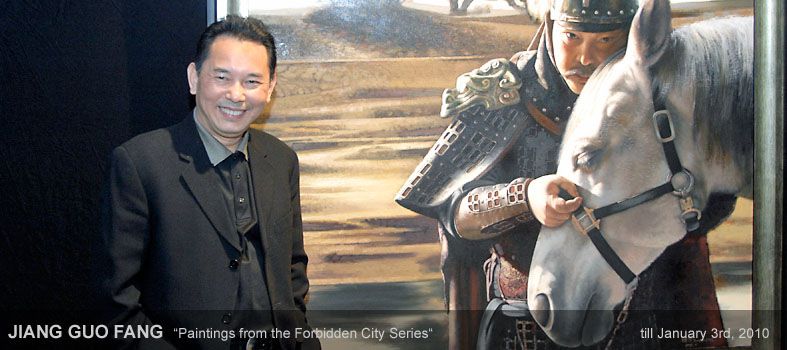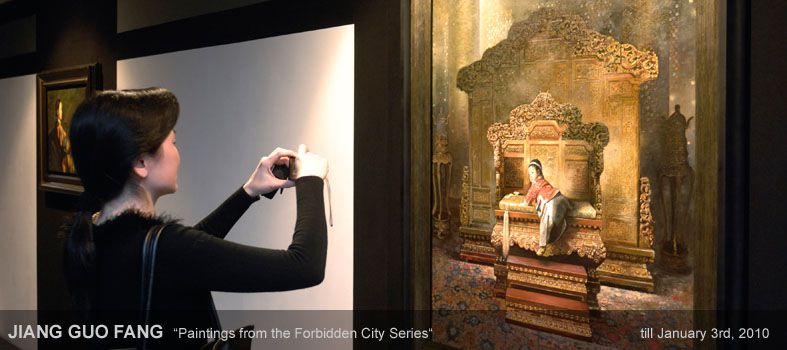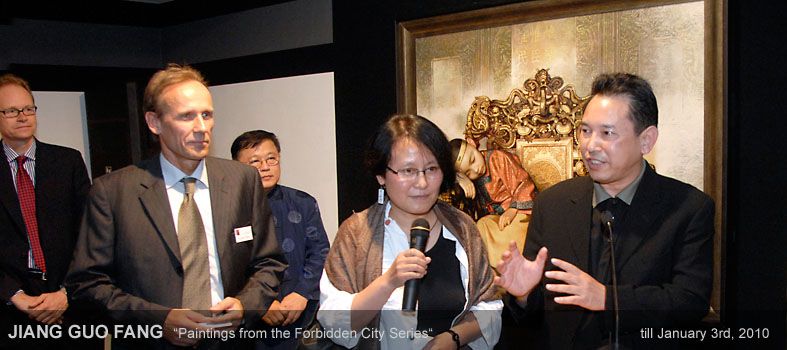
A Senior Palace Maid, 74 x 50 cm, 2003.5
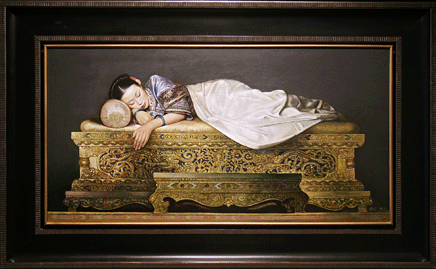
An Eternal Dream, 100 x 50 cm, 2009.5

Palace Door, 78 x 99cm, 2007

Leaving the Army, 140 x 150 cm, 2008.5
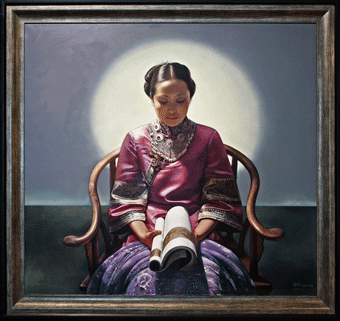
Reading Poems, 130 x 140 cm, 2008.5

Hibiscus in a Dream, 100 x 53 cm, 2009

Speakers for the Opening, from left: Mr. Siebert (Federal Foreign Office), Thomas Tyllack (Director Art Center Berlin), Mr. Li Xin (Minister Counsellor, Head of Cultural Department, Chinese Embassy), - Translator - right: Mr. Jiang Guo Fang (Artist)
JIANG GUO FANG
Oil Paintings from the FORBIDDEN CITY Series
till January 3rd, 2010
In 2004, as the first artist ever, Jiang Guo Fang had the honour of exhibiting in the Forbidden City. The only exhibition so far, with works from the "FORBIDDEN CITY" series in Europe, took place in the Palazzo Venzia in Rome, in 2005. In 2009, the paintings from Jiang Guo Fang's "The Forbidden City" series were exhibited in Berlin. This first exhibition by Jiang Guo Fang in Germany was curated by Thomas Tyllack.
Impressions from the opening of the exhibition on Sept. 23rd, 2009 here>>
Jiang Guo Fang was born in 1951. As a young man he was influenced by the Cultural Revolution and studied oil painting until 1978 at the Chinese National Academy of Fine Arts. After his graduation he initially started teaching and later assumed a professorship at the art department of the Central Institute of Drama in Beijing. Today Jiang Guo Fang is regarded as one of China's most significant contemporary artists.
"I began to paint a series of pictures on the Forbidden City in oil more than 30 years ago. Rather than saying these pictures are unlike those of the realistic "court painters," it is better to say they are unlike those of the realistic aestheticians. The so-called aestheticism, in the strict sense, means breaking away from reality. It is a relatively pure art, an art for the sake of art. Only the beautiful is the good. Only the beautiful is the true. But I am different. What I am after are the aesthetic elements in the historical subjects, elements with certain symbolic meanings. I reject pragmatism and do not wish my art to have a direct connection to real life. I hope that while appreciating my works, people may understand reality and history, the beautiful and the symbolic, human nature and nature itself in a broader sense. I draw attention to the national and traditional characters in my art, because the majestic long river of our history carries a vast and rich cultural heritage. Its wonder is closely associated with the regeneration of the Chinese nation. In the free space of imagination, it has lent a unique attraction to my art. This is what I believe in and what I pursue." Jiang Guo Fang
"Other than the emperor and princes, women in the rear quarters of the palace played leading roles in the paintings of the palace. Among these women were princesses, empresses, empress dowagers, imperial concubines, honourable imperial concubines, and other concubines, whose charm and beauty form an interesting picture of the palace. Palace women in China made up an important part of China's female culture. Most of the women painted in China were court ladies. By the Ming and Qing dynasties, these kinds of paintings had split into two stylistic categories. One category covered imperial court paintings, which were solemn in appearance, like the portrait of an empress we often see, or a so-called standard portrait today, with the same clothes and ornaments, composition and background. These works, which do not show the painter's own style and aesthetic taste, can hardly be called artistic creations. The other category included pictures of palace women painted freely by artists. Their diverse and colourful appeal stands for China's female culture and represents an indelible position and value within the history of art.
Women in the palace are a special subject for me. When I painted them, I did not have direct experience with them. Most of my knowledge of them comes from historical stories, paintings, movies and TV series. Stories about women in the palace are unavoidable in the plot of TV series about life in the Forbidden City. People seem to be very interested in them. There are three main reasons for me to paint women in the palace. 1. They allow me to create a large variety of shapes and apply rich colors. 2. As they are a special group of people, they are typical representatives of traditional Chinese culture and reflect the most lively and stirring side of culture in the palace. 3. Stories of women in the palace in both ancient times and today, in China and other countries, often become love stories. There are always stories covered by the dust of history and stories that are both enchanting and for people to sigh over. Their stories are therefore long lasting.
In the Qing dynasty, the women both in the palace, as well as ordinary people lived within a feudal ethical code that had prevailed for several thousand years. This ethical code was more strictly applied to women than men. In The Book of Change, written over 2,000 years ago, it is written, "As Heaven is noble and Earth lowly, they determine the ways of Heaven and Earth. The way of Heaven brings forth males, and the way of Earth females." In other words, it is a natural law that females are inferior to males. The Admonitions for Women, written by Ban Zhao of the Han dynasty, determines an even more systematic standard to regulate the words and conduct of women, proposing that a woman must adhere to "three obediences and four virtues" (obedience to father, husband and son, morality, proper speech, modest manner, and diligent work.) It initially shaped traditional Chinese female culture, and acted as an invisible black net ensnaring all women. Neither the women in the palace, nor the women of ordinary families could escape from this mental shackle. In addition, women at the palace faced an additional invisible spectre. This spectre was the open strife and veiled struggle among the women of the palace. The magnificent palace in which the women lived was a black hole reeking of blood, where, spurred by jealousy and the desire to gain favour, women resorted to deception and fraud, and killed one another no less brutally than the men who fought on the battlefield." Jiang Guo Fang
Jiang Guo Fang's work is essentially influenced by his altercation with the occidental art. He was trained in Eastern as well as in Western painting techniques, but the traditional aesthetics of Chinese painting are important to him as well. In an impressive way he combines Chinese painting tradition with that of old European masters. Equipped with an extensive knowledge about the dynasties of the Chinese emperors his works reflect the rediscovery and re-evaluation of his country's history.
The paintings of the "FORBIDDEN CITY" series, portraits and scenes from the 600 years old imperial palace, have their own unique expression due to the distinctive painting style he has developed. Unswervingly Jiang Guo Fang strives for artistic perfection, which occasionally he is trying to find by painting variations of one motif, changing size, composition and colours. His masterful paintings bring back to life the Forbidden City and its history, symbol and mysticism of the great Chinese emperors.
The Forbidden City in Beijing is a symbol of China as only the Great Wall can be. Here ruled the last emperor of the Quing Dynasty (1644-1911), the last dynasty which followed after Ming (1368-1644). In 1405 emperor Yongle of the Ming Dynasty moved the capital of the Chinese empire from Nanking to Beijing. Between 1407 and 1420 the construction of the monumental palace began. The area with its hundreds of palaces and thousands of rooms is the embodiment of the many thousand years old Chinese civilisation and culture.
"Jiang Guo Fang is an artist who displays great courage in art by placing its fate in the Forbidden City, the former imperial palace in China, and dares to hold a one-man show in the Forbidden City with his series of paintings of the very same site. Later, his Forbidden City series was brought to Rome's Palazzo Venezia, Italy, where his oeuvre was on display for two and a half months. In this brief period Jiang Guo Fang travelled from the former imperial palace to Palazzo Venezia, a figurative road of art from the East to the West.
We should say that Jiang Guo Fang's courage in art stems from his confidence in his own art's power. Powerful art is often heavy. Looking at Jiang Guo Fang's work, one cannot feel cheer, but one can feel its heaviness and even the heaviness of his canvas, colours, and paint brush. He painted not only the Forbidden City and the people in it, but also his feelings and thoughts. His feelings and thought are heavy, and so the pictures are, as well. He has painted the heaviness of Chinese imperial dynastic history of several thousand years, the heaviness of the last imperial dynasty, and the shadowy heaviness of something that is still lingers.
Choosing the Forbidden City as a subject means choosing its heaviness, and that cannot be replaced. When pictures are forceful and heavy, they cannot be replaced. They belong to Jiang Guo Fang's distinctive artistic creations." Li Wenru, Vice-President of the Palace Museum
More paintings and info here>>
